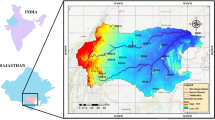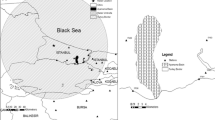Abstract
In applied hydrology, estimating the peak flood discharge in ungauged or poorly gauged river sections is vital for urbanized areas. Spatially distributed rainfall data such as weather radar data may be a good choice to represent the driving force in hydrologic models for ungauged regions. However, it is important to examine the accuracy of this product, especially over mountainous regions. The bias between radar rainfall and rain gauge rainfall can be progressively removed by using information provided by rain gauges. The Kalman Filter algorithm is applied for the mean field bias correction of radar rainfall data using past estimates and observations. Regarding the bias-correction methods, two filtering approaches are developed from 8 events observed at 13 rain gauge stations, and the bias-corrected radar (BCR) rainfall data are used to compare simulated and observed hydrographs for the three flood events that caused severe consequences in Samsun–Terme. It is found out that in frontal type rainfall, BCR rainfall estimates improve the Nash–Sutcliffe efficiency from 0.56 to 0.80 in runoff simulation of the event occurred on 22 November 2014; however, simulations of the event occurred on 2 August 2015 and 28 May 2016 have poorer statistical results probably owing to the effect of convective type rainfall and snow melting, respectively.
















Similar content being viewed by others
References
Abon CC, Kneis D, Crisologo I, Bronstert A, David CPC, Heistermann M (2016) Evaluating the potential of radar-based rainfall estimates for streamflow and flood simulations in the Philippines. Geomat Natl Hazards Risk 7(4):1390–1405
Ahnert PR, Krajewski WF, Johnson ER (1986) Kalman filter estimation of radar-rainfall field bias. In: Preprints 23rd Conference on radar meteorology snowmass. American Meteorological Society JP33-JP37
Alexanderson HA (1986) A homogeneity test applied to precipitation data. J Climatol 6:661–675
Anagnostou EN, Krajewski WF, Seo DJ, Johnson ER (1998) Mean-field rainfall bias studies for WSR-88D. J Hydrol Eng 3(3):149–159
Anderson ML, Chen ZQ, Kavvas ML, Feldman A (2000) Coupling HEC-HMS with atmospheric models for the prediction of watershed runoff. In: Building partnerships, pp 1–10
Andrieu H, Creutin JD, Delrieu G, Faure D (1997) Use of a weather radar for the hydrology of a mountainous area. Part I: radar measurement interpretation. J Hydrol 193(1):1–25
Anscombe F, Glynn W (1983) Distribution of kurtosis statistic for normal statistics. Biometrika 70:227–234
Arnaud P, Lavabre J, Fouchier C, Diss S, Javelle P (2011) Sensitivity of hydrological models to uncertainty in rainfall input. Hydrol Sci J 56(3):397–410
Austin PM (1987) Relation between measured radar reflectivity and surface rainfall. Mon Weather Rev 115(5):1053–1070
Bartholmes J, Todini E (2005) Coupling meteorological and hydrological models for flood forecasting. Hydrol Earth Syst Sci Dis 9(4):333–346
Battan LJ (1973) Radar observations of the atmosphere. The University of Chicago Press, Chicago, IL
Bech J, Codina B, Lorente J, Bebbington D (2003) The sensitivity of single polarization weather radar beam blockage correction to variability in the vertical refractivity gradient. J Atmos Ocean Technol 20(6):845–855
Borga M (2002) Accuracy of radar rainfall estimates for streamflow simulation. J Hydrol 267(1):26–39
Chesworth W (2008) Encyclopedia of soil science. Springer, ISBN 978-1-4020-3995-9
Choudhari K, Panigrahi B, Paul JC (2014) Simulation of rainfall-runoff rainfall–runoff process using HEC-HMS model for Balijore Nala watershed, Odisha, India. Int J Geomat Geosci 5(2):253–265
Chu X, Steinman A (2009) Event and continuous hydrologic modeling with HEC-HMS. J Irrig Drain Eng 135(1):119–124
Chumchean S, Sharma A, Seed A (2003) Radar rainfall error variance and its impact on radar rainfall calibration. Phys Chem Earth Parts A/B/C 28(1):27–39
Chumchean S, Seed A, Sharma A (2006) Correcting of real-time radar rainfall bias using a Kalman filtering approach. J Hydrol 317(1):123–137
Collier CG (1996) Applications of weather radar systems: a guide to uses of radar data in meteorology and hydrology. Wiley, Hoboken
Conrad V, Pollak LW (1950) Methods in climatology. Harvard University Press, Cambridge
Cunge JA (1969) On the subject of a flood propagation computation method (Muskingum method). J Hydraul Res 7(2):205–230
Cunha LK, Mandapaka PV, Krajewski WF, Mantilla R, Bradley AA (2012) Impact of radar-rainfall error structure on estimated flood magnitude across scales: an investigation based on a parsimonious distributed hydrological model. Water Resour Res 48(10):W10515
DSİ VII. Bölge Müdürlüğü (2014) Samsun İli, Salıpazarı İlçesi, Kayaköprü Mevkii, ÇED Raporu, DSİ
D’Agostino R, Pearson ES (1973) Tests for departure from normality. Empirical results for the distributions of b2 and√b1. Biometrika 60(3):613–622
Durbin J, Knott M (1972) Components of Cramer–von Mises statistics. I. J R Stat Soc Ser B (Methodol) 34:290–307
Field A (2009) Discovering statistics using SPSS. Sage Publications, Thousand Oaks
Fread DL (1983) A unified coefficient routing model. In: Paper present at seminar, Department of Civil Engineering Pa State University, University Park
Gerstner EM, Heinemann G (2008) Real-time areal precipitation determination from radar by means of statistical objective analysis. J Hydrol 352(3):296–308
Ghasemi A, Zahediasl S (2012) Normality tests for statistical analysis: a guide for non-statisticians. Int J Endocrinol Metab 10(2):486
Gjertsen U, Salek M, Michelson DB (2004) Gauge adjustment of radar-based precipitation estimates in Europe. In: Proceedings of ERAD 7(11)
Grewal MS, Andrews AP (1993) Kalman filtering: theory and practice. Wiley, Hoboken
Habib E, Qin L, Seo DJ, Ciach GJ, Nelson BR (2012) Independent assessment of incremental complexity in NWS multisensor precipitation estimator algorithms. J Hydrol Eng 18(2):143–155
Hand WH, Fox NI, Collier CG (2004) A study of twentieth-century extreme rainfall events in the United Kingdom with implications for forecasting. Meteorol Appl 11(1):15–31
Harrold TW, English EJ, Nicholass CA (1974) The accuracy of radar-derived rainfall measurements in hilly terrain. Q J R Meteorol Soc 100(425):331–350
He X, Refsgaard JC, Sonnenborg TO, Vejen F, Jensen KH (2011) Statistical analysis of the impact of radar rainfall uncertainties on water resources modeling. Water Res Res. https://doi.org/10.1029/2011WR010670
Hildebrand PH (1978) Iterative correction for attenuation of 5 cm radar in rain. J Appl Meteorol 17(4):508–514
Hossain F, Anagnostou EN, Dinku T, Borga M (2004) Hydrological model sensitivity to parameter and radar rainfall estimation uncertainty. Hydrol Process 18(17):3277–3291
Houze RA (1997) Stratiform precipitation in regions of convection: A meteorological paradox? Bull Am Meteorol Soc 78(10):2179–2196
Ide K, Courtier P, Ghil M, Lorenc AC (1997) Unified notation for data assimilation: operational, sequential and variational (special issue data assimilation in meteorology and oceanography: theory and practice). J Meteorol Soc Jpn 75(1B):181–189
Jarque CM, Bera AK (1987) A test for normality of observations and regression residuals. Int Stat Rev 53:163–172
Joss J, Waldvogel A (1970) A method to improve the accuracy of radar measured amounts of precipitation. In: 14th Conference on radar meteorology, vol: 237238
Kalman RE (1960) A new approach to linear filtering and prediction problems. J Basic Eng 82(1):35–45
Kim J, Yoo C (2014) Use of a dual Kalman filter for real-time correction of mean field bias of radar rain rate. J Hydrol 519:2785–2796
Kitchen M, Brown R, Davies AG (1994) Real-time correction of weather radar data for the effects of bright band, range and orographic growth in widespread precipitation. Q J R Meteorol Soc 120(519):1231–1254
Lilliefors HW (1967) On the Kolmogorov–Smirnov test for normality with mean and variance unknown. J Am Stat Assoc 62(318):399–402
Maidment DR (1993) Handbook of hydrology, vol 1. McGraw-Hill, New York
Marshall JS, Palmer WMK (1948) The distribution of raindrops with size. J Meteorol 5(4):165–166
Maynard RH (1945) Radar and weather. J Meteorol 2(4):214–226
Pereira Fo AJ, Crawford KC, Hartzell CL (1998) Improving WSR-88D hourly rainfall estimates. Weather Forecast 13(4):1016–1028
Pettitt AN (1977) Testing the normality of several independent samples using the Anderson–Darling statistic. Appl Stat 26:156–161
Pratama A, Irawan DE, Susanto A, Ardi RDW (2016) Influence of lithology and slope gradient to infiltration of the Mount Malabar, West Java. In: IOP conference series: earth and environmental science, vol 29, no 1, pp 12–25
Razali NM, Wah YB (2011) Power comparisons of Shapiro–Wilk, Kolmogorov–Smirnov, Lilliefors and Anderson–Darling tests. J Stat Model Anal 2(1):21–33
Seo DJ, Breidenbach JP, Johnson ER (1999) Real-time estimation of mean field bias in radar rainfall data. J Hydrol 223(3):131–147
Shapiro SS, Wilk MB, Chen HJ (1968) A comparative study of various tests for normality. J Am Stat As 63:1343–1372
Smith JA, Krajewski WF (1991) Estimation of the mean field bias of radar rainfall estimates. J Appl Meteorol 30(4):397–412
Soytekin A (2010) Evaluating the use of satellite-based precipitation estimates for discharge estimation in ungauged basins. Master Thesis, Middle East Technical University
Sun X, Mein RG, Keenan TD, Elliott JF (2000) Flood estimation using radar and raingauge data. J Hydrol 239(1):4–18
Tachikawa Y (2003) Weather radar information and distributed hydrological modelling. In: Proceedings of an international symposium (symposium HS03) at Sapporo, Japan. (No. 282). International Association of Hydrological Sciences
Te Chow V (1959) Open channel hydraulics. McGraw-Hill Book Company, Inc, New York
Tedela NH, McCutcheon SC, Rasmussen TC, Hawkins RH, Swank WT, Campbell JL, Tollner EW (2011) Runoff curve numbers for 10 small forested watersheds in the mountains of the eastern United States. J Hydrol Eng 17(11):1188–1198
Tewolde MH, Smithers JC (2006) Flood routing in ungauged catchments using Muskingum methods. J Water S Afr 32(3):379–388
Thompson WR (1935) On a criterion for the rejection of observations and the distribution of the ratio of deviation to sample standard deviation. Ann Math Stat 6(4):214–219
Todini E (2001) A Bayesian technique for conditioning radar precipitation estimates to rain-gauge measurements. Hydrol Earth Syst Sci Dis 5(2):187–199
USDA Soil Conservation Service (1986) National engineering manual. US Government Printing Office, Washington, DC
Verworn A, Haberlandt U (2011) Spatial interpolation of hourly rainfall-effect of additional information, variogram inference and storm properties. Hydrol Earth Syst Sci 15:569–584
Viessman W, Lewis GL, Knapp JW (1989) Introduction to hydrology. Harper and Row, New York
Vieux BE, Bedient PB (1998) Estimation of rainfall for flood prediction from WSR-88D reflectivity: a case study. Weather Forecast 13(2):407–415
Welch G, Bishop G (2006) An introduction to the Kalman filter. Department of Computer Science, University of North Carolina, Chapel Hill
Wright DB, Smith JA, Villarini G, Baeck ML (2012) Hydroclimatology of flash flooding in Atlanta. Water Resour Res 48(4):W04524
Yoo C, Park C, Yoon J, Kim J (2014) Interpretation of mean-field bias correction of radar rain rate using the concept of linear regression. Hydrol Process 28(19):5081–5092
Yucel I (2015) Assessment of a flash flood event using different precipitation datasets. Nat Hazards 79(3):1889–1911
Yusop Z, Chan CH, Katimon A (2007) Runoff characteristics and application of HEC-HMS for modelling stormflow hydrograph in an oil palm catchment. Water Sci Technol 56(8):41–48
Zhou Y, McLaughlin D, Entekhabi D (2006) Assessing the performance of the ensemble Kalman filter for land surface data assimilation. Mon Weather Rev 134(8):2128–2142
Zhu D, Xuan Y, Cluckie I (2014) Hydrological appraisal of operational weather radar rainfall estimates in the context of different modelling structures. Hydrol Earth Syst Sci 18(1):257–272
Acknowledgements
Much of the work described here is the result of a project Funded by METU (BAP-03-03-2015-001). The WRF, radar and gauge rainfall data were provided by the State Meteorological Office, and discharge data were provided by the State Water Works. Snow cover data were provided by EUMETESAT in the framework of the EUMETSAT Satellite Application Facility in Support of Operational Hydrology and Water Management (H-SAF) project. A. Ozkaya acknowledges support of the Scientific and Technological Research Council of Turkey (TUBITAK) BIDEB 2211-A PhD Scholarship Program.
Author information
Authors and Affiliations
Corresponding author
Additional information
Publisher's Note
Springer Nature remains neutral with regard to jurisdictional claims in published maps and institutional affiliations.
Rights and permissions
About this article
Cite this article
Ozkaya, A., Akyurek, Z. Evaluating the use of bias-corrected radar rainfall data in three flood events in Samsun, Turkey. Nat Hazards 98, 643–674 (2019). https://doi.org/10.1007/s11069-019-03723-z
Received:
Accepted:
Published:
Issue Date:
DOI: https://doi.org/10.1007/s11069-019-03723-z




